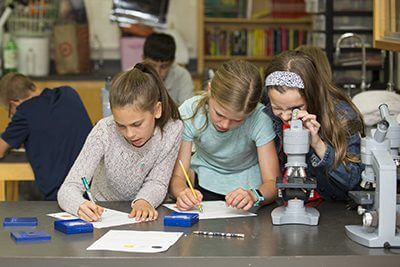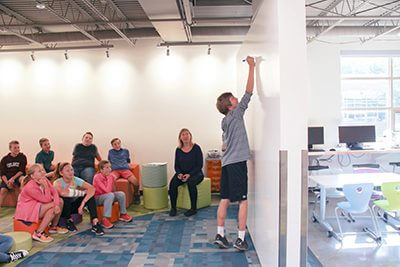September 15, 2017
 One-dimensional teaching creates one-dimensional learners, and today’s world is too complex for linear thinking. From PreK through 12th grade, MPA students explore topics and ideas through multiple disciplines, examining problems and situations with insight from the sciences, math, arts, and humanities.
One-dimensional teaching creates one-dimensional learners, and today’s world is too complex for linear thinking. From PreK through 12th grade, MPA students explore topics and ideas through multiple disciplines, examining problems and situations with insight from the sciences, math, arts, and humanities.
Recently, hurricanes ravaged Texas, Florida, and the Caribbean, dominating our news cycles and public consciousness. How would MPA faculty approach a lesson on Harvey and Irma?
Science faculty would examine weather patterns, track the storms, evaluate the destruction, and analyze climate change. Math teachers might use hurricane-related figures in their problems or examine all of the calculations involved in monitoring or categorizing the storm or evacuating millions of people.
Social studies teachers might examine early explorers’ descriptions of Florida as uninhabitable swampland, debate land-use issues surrounding the control of water, and discuss how history might inform how best to rebuild. English teachers might use survival narratives or writing exercises as part of their hurricane-related curriculum. Engineering classes could examine the destruction with an eye toward the buildings that withstood the storm, and ones that didn’t. Technology would be used in meaningful ways throughout all of these lessons.
This hypothetical example reflects the MPA approach to interdisciplinary teaching, particularly the grounding of science, technology, engineering, and math (STEM) in a progressive, liberal arts college prep curriculum. The cross-curricular integration of STEM with the humanities has been present since MPA’s founding in 1982, long before STEM and STEAM (science, technology, engineering, art, and math) became today’s top educational buzzwords. Many schools are now emphasizing classes in these areas, though most teach them in a one-dimensional way with each aspect of STEM or STEAM taught separately. In contrast, STEM and STEAM are not new initiatives to MPA; they have always been central to an MPA education and taught in interdisciplinary ways.
“If subjects are taught in one dimension, the kids only see one dimension. But that’s not very interesting,” said Kari O’Keefe, first grade teacher. “At MPA, education is in 3D. That’s what creates the richness of the understanding.”
 Flexibility Key to STEAM Curriculum
Flexibility Key to STEAM Curriculum
Successfully combining science, technology, and math with arts and the humanities requires academic and professional freedom not often found in many schools today. MPA’s intimate size, close community, and commitment to collaboration enables us to effectively deliver a strong STEAM education. Instructors know what their colleagues are teaching, and they know how to collaboratively weave concepts together in a meaningful way for students. The MPA curriculum is purposely flexible so teachers can collaborate, building creative, cross-discipline lessons and approaches to the topic at hand.
An MPA education is not just flexible because teachers have more freedom to collaborate. Students have more flexibility to explore the subjects that spark their intellectual passion. At the Upper School level, we design the schedule so students can take three or four electives each year. Students do not need to choose between choir and engineering design or between ceramics and advanced argumentation. Our students can be mathematicians, scientists, and artists simultaneously; it’s the time-honored and time-tested MPA way. We believe that all students benefit from exploring subjects across the academic disciplines.
“The arts allow students to see the world in new and different ways, and that new vision will allow them to apply their science, technology, engineering, and math knowledge with the creativity and innovation our 21st century world needs,” said Daniel Ethier, Middle School math teacher.
Interdisciplinary Approach Builds Future Leaders
A holistic approach to teaching and learning allows students to develop skills such as creative problem solving, empathy, perseverance, and more that will serve them well in the future. We have more access to information and knowledge today than ever before, and critical, creative, and innovative thinking is crucial to successfully addressing our world’s most pressing issues.
Understanding the interconnectedness of our world and the complexity of global challenges typically comes much later in life. However, from the start of their education, MPA students are building skills to examine issues from multiple perspectives, listen carefully, and communicate effectively. MPA students will be ready to work in an environment where many people need to come together to share knowledge and ideas to develop innovative solutions.
“I think creative thinking builds tolerance with ambiguity, and allows for building connections and successfully communicating and partnering with others,” said Mikki Williams, a Lower School parent. “I have no idea how to teach my child this, so I am grateful it is being introduced at such a young age. It will simply become part of her foundational thinking as she prepares for who she will become out in the world.”
 New Makerspace to Further Strengthen STEAM at MPA
New Makerspace to Further Strengthen STEAM at MPA
The interdisciplinary teaching and learning inherent in STEAM takes place across MPA, in nearly every classroom. But a generous $500,000 gift enabled MPA to build a hands-on, creative center for the MPA community and beyond to gather, share, create, innovate, and inspire each other as they engage in STEAM disciplines both during and outside of school hours.
The 2,300-square-foot Makerspace serves as a resource room used by all different classes, across each division, and in different contexts, providing opportunities for students to follow their own intrinsic path to discovery, enabling them to take control of their own learning. Students now have the tools and materials right there to pursue practical, hands-on, interdisciplinary, problem-based projects. In many ways, the Makerspace builds on other MPA innovations—the i-Lab, the Digital Fabrication Studio, and Robotics Lab—that encourage our students to ideate in big and small ways.
In addition to advancing MPA’s success in the STEAM disciplines, the Makerspace advances character development as students take risks, develop skills in perseverance, and iterate from perceived failures to achieve success. “Through it, character-building traits collectively known as grit, including creativity, curiosity, open-mindedness, persistence, social responsibility, and teamwork are being nurtured,” said Dr. Bill Hudson, Head of School.
Our approach to STEAM mirrors our approach to an MPA education overall. At every level of education, MPA fosters a spirit of innovation that fuels creative thinking and sparks a passion for learning. Across our classes, MPA teachers emphasize critical thinking, problem solving, and deep understanding over rote memorization, creating active and engaging learning opportunities with real-world implications.
We invite you to learn more about an MPA education by visiting www.moundsparkacademy.org, and welcome you to our new Makerspace.